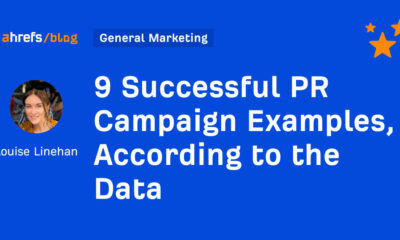MARKETING
5 Dos and Don’ts When Making a SMART Goal [Examples]
![5 Dos and Don'ts When Making a SMART Goal [Examples] 5 Dos and Don'ts When Making a SMART Goal [Examples]](https://articles.entireweb.com/wp-content/uploads/2022/01/5-Dos-and-Donts-When-Making-a-SMART-Goal-Examples.jpgkeepProtocol.jpeg)
Every year I create vague New Years resolutions, but this year I decided to try something different.
Using the SMART goal framework (specific, measurable, attainable, relevant, and time-bound), I reworded my 2022 goal from “read more books” to “read two books per month to hit my goal of reading 24 before the end of the year.”
The SMART framework is an effective strategy for creating more specific and attainable goals. Plus, it provides benchmarks against which you can measure your progress — if you have a larger, more daunting goal, smaller steps can help you remain motivated.
Here, let’s explore what SMART goals are, why they’re important, and how to make your own.
![5 Dos and Don'ts When Making a SMART Goal [Examples] SMART Goals Template from HubSpot](https://articles.entireweb.com/wp-content/uploads/2022/01/1643231827_259_5-Dos-and-Donts-When-Making-a-SMART-Goal-Examples.png) Download this Template for Free
Download this Template for Free
In the working world, the influence of SMART goals continues to grow. The reason why successful marketing teams always hit their numbers is that they also set SMART goals. Use the template above to follow along and create your own SMART goals.
What are SMART goals?
SMART goals are concrete targets that you aim to hit over a certain period. These goals should be carefully drafted by a manager and their direct report to set them up for success. “SMART” is an acronym that describes the most important characteristics of each goal.
The “SMART” acronym stands for “specific,” “measurable,” “attainable,” “relevant,” and “time-bound.” Each SMART goal should have these five characteristics to ensure the goal can be reached and benefits the employee. Find out what each characteristic means below, and how to write a SMART goal that exemplifies them.
Why are SMART goals important?
SMART goals are important to set as they:
- Help you work with clear intentions, not broad or vague goals
- Provide a method to gauge your success by setting benchmarks to meet
- Give sensible objectives that are realistic and achievable
- Cut out unnecessary or irrelevant work that could take away from what’s important
- Set a clear beginning and end to adhere to in reaching your goals
When you make goals that are specific, measurable, attainable, relevant, and time-bound, you’re increasing your odds for success by verifying that the goal is achievable, identifying the metrics that define success, and creating a roadmap to reach those metrics.
If your goals are abstract, if you don’t know what it will take to achieve success, or if you don’t give yourself a deadline to complete steps, you may lose focus and fall short of what you want to accomplish.
Do SMART goals actually work?
In short — yes, if done correctly.
For instance, one study found 76% of participants who wrote down their goals, made a list of goal-driven actions, and provided weekly progress reports to a friend achieved their goals — which is 33% higher than those with unwritten goals.
Additionally, I polled roughly 300 participants in the U.S. and found 52% believe SMART goals help them achieve their goals more often than if they didn’t use a SMART framework.
![5 Dos and Don'ts When Making a SMART Goal [Examples] SMART goals statistic showing people believe SMART goals work](https://articles.entireweb.com/wp-content/uploads/2022/01/1643231827_42_5-Dos-and-Donts-When-Making-a-SMART-Goal-Examples.png)
Setting unrealistic goals and trying to measure them without consideration of previous performance, overly short time frames, or including too many variables will lead you off course.
However, these goals work only if formulated properly and if they take into account the motive and cadence of those working on them. Additionally, your SMART goals can only succeed when the employees working towards them have the means to achieve them.
Let’s take a look at some realistic examples of SMART goals to paint a clearer picture of what they are.
1. Blog Traffic Goal
- Specific: I want to boost our blog’s traffic by increasing our weekly publishing frequency from five to eight times a week. Our two bloggers will increase their workload from writing two posts a week to three posts a week, and our editor will increase her workload from writing one post a week to two posts a week.
- Measurable: Our goal is an 8% increase in traffic.
- Attainable: Our blog traffic increased by 5% last month when we increased our weekly publishing frequency from three to five times a week.
- Relevant: By increasing blog traffic, we’ll boost brand awareness and generate more leads, giving sales more opportunities to close.
- Time-Bound: End of this month
- SMART Goal: At the end of this month, our blog will see an 8% lift in traffic by increasing our weekly publishing frequency from five posts per week to eight posts per week.
![5 Dos and Don'ts When Making a SMART Goal [Examples] smart goal example on blog traffic](https://articles.entireweb.com/wp-content/uploads/2022/01/1643231827_416_5-Dos-and-Donts-When-Making-a-SMART-Goal-Examples.png)
2. Facebook Video Views Goal
- Specific: I want to boost our average views per native video by cutting our video content mix from eight topics to our five most popular topics.
- Measurable: Our goal is a 25% increase in views.
- Attainable: When we cut down our video content mix on Facebook from 10 topics to our eight most popular topics, our average views per native video increased by 20%.
- Relevant: By increasing average views per native video on Facebook, we’ll boost our social media following and brand awareness, reaching more potential customers with our video content.
- Time-Bound: In six months
- SMART Goal: In six months, we’ll see a 25% increase in average video views per native video on Facebook by cutting our video content mix from eight topics to our five most popular topics.
3. Email Subscription Goal
- Specific: I want to boost the number of email blog subscribers by increasing our Facebook advertising budget on blog posts that historically acquire the most email subscribers.
- Measurable: Our goal is a 50% increase in subscribers.
- Attainable: Since we started using this tactic three months ago, our email blog subscriptions have increased by 40%.
- Relevant: By increasing the number of email blog subscribers, our blog will drive more traffic, boost brand awareness, and drive more leads to our sales team.
- Time-Bound: In three months
- SMART Goal: In three months, we’ll see a 50% increase in the number of email blog subscribers by increasing our Facebook advertising budget on posts that historically acquire the most blog subscribers.
4. Webinar Sign-Up Goal
- Specific: I want to increase the number of sign-ups for our Facebook Messenger webinar by promoting it through social, email, our blog, and Facebook Messenger.
- Measurable: Our goal is a 15% increase in sign-ups.
- Attainable: Our last Facebook messenger webinar saw a 10% increase in sign-ups when we only promoted it through social, email, and our blog.
- Relevant: When our webinars generate more leads, sales have more opportunities to close.
- Time-Bound: By April 10, the day of the webinar
- SMART Goal: By April 10, the day of our webinar, we’ll see a 15% increase in sign-ups by promoting it through social, email, our blog, and Facebook messenger.
![5 Dos and Don'ts When Making a SMART Goal [Examples] smart goal example on webinar sign-ups](https://articles.entireweb.com/wp-content/uploads/2022/01/1643231827_830_5-Dos-and-Donts-When-Making-a-SMART-Goal-Examples.png)
5. Landing Page Performance Goal
- Specific: I want our landing pages to generate more leads by switching from a one-column form to a two-column form.
- Measurable: My goal is a 30% increase in lead generation.
- Attainable: When we A/B tested our traditional one-column form versus a two-column form on our highest-traffic landing pages, we discovered that two-column forms convert 27% better than our traditional one-column forms, at a 99% significance level.
- Relevant: If we generate more content leads, sales can close more customers.
- Time-Bound: One year from now
SMART Goal: One year from now, our landing pages will generate 30% more leads by switching their forms from one column to two columns.
6. Link-Building Strategy Goal
- Specific: I want to increase our website’s organic traffic by developing a link-building strategy that gets other publishers to link to our website. This increases our ranking in search engine results, allowing us to generate more organic traffic.
- Measurable: Our goal is 40 backlinks to our company homepage.
- Attainable: According to our SEO analysis tool, there are currently 500 low-quality links directing to our homepage from elsewhere on the internet. Given the number of partnerships we currently have with other businesses, and that we generate 10 new inbound links per month without any outreach on our part, an additional 40 inbound links from a single link-building campaign is a significant but feasible target.
- Relevant: Organic traffic is our top source of new leads, and backlinks are one of the biggest ranking factors on search engines like Google. If we build links from high-quality publications, our organic ranking increases, boosting our traffic and leads as a result.
- Time-Bound: four months from now
- SMART Goal: Over the next four months, I will build 40 additional backlinks that direct to www.ourcompany.com. To do so, I will collaborate with Ellie and Andrew from our PR department to connect with publishers and develop an effective outreach strategy.
7. Reducing Churn Rate Goal
- Specific: I want to reduce customer churn by 5% for my company because every customer loss is a reflection of our service’s quality and perception.
- Measurable: Contact 30 at-risk customers per week and provide customer support daily for five new customers during their onboarding process.
- Attainable: Our product offering has just improved and we have the means to invest more into our customer support team, and could potentially have five at-risk customers to upscale monthly.
- Relevant: We can set up a customer knowledge base to track customers’ progression in the buyer’s journey, and prevent churn by contacting them before they lose interest.
- Time-Bound: In 24 weeks
- SMART Goal: In 24 weeks, I will reduce the churn rate by 5% for my company. To do so, we will contact 30 at-risk customers per week and provide/invest in customer support to assist five new customers during onboarding daily and track their progress through a customer knowledge base.
8. Brand Affinity Goal
- Specific: I want to increase our podcast listener count as we are trying to establish ourselves as thought leaders in our market.
- Measurable: A 40% increase in listeners is our goal.
- Attainable: We can increase our current budget and level our podcaster’s cadence, to have the means to hold insightful conversations for our listeners to tune into.
- Relevant: We created a podcast and have dedicated a team to source interesting guests, sound mixing, and eye-catching thumbnails to get it started.
- Time-Bound: In four months
- SMART Goal: In four months, we’ll see a 40% increase in average listener count in Apple Podcasts by providing our team the budget and cadence to make insightful podcasts with quality sound mixing and eye-catching thumbnails.
9. Podcast Listener Count Goal
- Specific: I want to boost our podcast’s listener count by promoting our podcast across social channels. We will post four quotes related to new podcast episodes throughout the month on our Twitter account, and we will post six short videos of our podcast conversations with guests on our Instagram account throughout the month.
- Measurable: Our goal is an 20% increase in podcast listeners.
- Attainable: Our podcast listener count increased by 5% last month when we published two short videos of our podcast conversation on Instagram.
- Relevant: By increasing podcast listener count, we’ll boost brand awareness and generate more leads, giving sales more opportunities to close.
- Time-Bound: End of this month
- SMART Goal: At the end of this month, our podcast will see an 20% increase in listeners by increasing our social media promotions from two Instagram posts to four Twitter posts and six Instagram posts.
10. In-Person Event Attendee Goal
- Specific: I want to boost attendance at our upcoming in-person event by 50% by sending out three email reminders to our subscriber lists each week before the event.
- Measurable: Our goal is an 50% increase in attendees.
- Attainable: Our attendee number increased by 20% last year when we sent out one email reminder to our subscriber lists.
- Relevant: By increasing attendee count, we’ll increase brand loyalty by providing value to our existing customers, and generate more leads.
- Time-Bound: August 30
- SMART Goal: By the time of our event on August 30th, our attendee number will increase by 50% from where it’s at now (250 attendees), by sending out three email reminders to our subscribers lists.
Now that you’ve seen examples of SMART goals, let’s dive into how to make your own.
How To Make a SMART Goal
- Use specific wording.
- Include measurable goals.
- Aim for realistically attainable goals.
- Pick relevant goals that relate to your business.
- Make goals time-bound by including a timeframe and deadline information.
1. Use specific wording.
When writing SMART goals, keep in mind that they are “specific” in that there’s a hard and fast destination the employee is trying to reach. “Get better at my job,” isn’t a SMART goal because it isn’t specific. Instead, ask yourself: What are you getting better at? How much better do you want to get?
If you’re a marketing professional, your job probably revolves around key performance indicators or KPIs. Therefore, you might choose a particular KPI or metric that you want to improve on — like visitors, leads, or customers. You should also identify the team members working toward this goal, the resources they have, and their plan of action.
In practice, a specific SMART goal might say, “Clifford and Braden will increase the blog’s traffic from email …” You know exactly who’s involved and what you’re trying to improve on.
Common SMART Goal Mistake: Vagueness
While you may need to keep some goals more open-ended, you should avoid vagueness that could confuse your team later on. For example, instead of saying, “Clifford will boost email marketing experiences,” say “Clifford will boost email marketing click rates by 10%.”
2. Include measurable goals.
SMART goals should be “measurable” in that you can track and quantify the goal’s progress. “Increase the blog’s traffic from email,” by itself, isn’t a SMART goal because you can’t measure the increase. Instead, ask yourself: How much email marketing traffic should you strive for?
If you want to gauge your team’s progress, you need to quantify your goals, like achieving an X-percentage increase in visitors, leads, or customers.
Let’s build on the SMART goal we started three paragraphs above. Now, our measurable SMART goal might say, “Clifford and Braden will increase the blog’s traffic from email by 25% more sessions per month … ” You know what you’re increasing, and by how much.
Common SMART Goal Mistake: No KPIs
This is in the same light of avoiding vagueness. While you might need qualitative or open-ended evidence to prove your success, you should still come up with a quantifiable KPI. For example, instead of saying, “Customer service will improve customer happiness,” say, “We want the average call satisfaction score from customers to be a seven out of ten or higher.”
3. Aim for realistically attainable goals.
An “attainable” SMART goal considers the employee’s ability to achieve it. Make sure that X-percentage increase is rooted in reality. If your blog traffic increased by 5% last month, try to increase it by 8-10% this month, rather than a lofty 25%.
It’s crucial to base your goals on your own analytics, not industry benchmarks, or else you might bite off more than you can chew. So, let’s add some “attainability” to the SMART goal we created earlier in this blog post: “Clifford and Braden will increase the blog’s traffic from email by 8-10% more sessions per month … ” This way, you’re not setting yourself up to fail.
Common SMART Goal Mistake: Unattainable Goals
Yes. You should always aim to improve. But reaching for completely unattainable goals may knock you off course and make it harder to track progress. Rather than saying, “We want to make 10,000% of what we made in 2021,” consider something more attainable, like, “We want to increase sales by 150% this year,” or “We have a quarterly goal to reach a 20% year-over-year sales increase.”
4. Pick relevant goals that relate to your business.
SMART goals that are “relevant” relate to your company’s overall business goals and account for current trends in your industry. For instance, will growing your traffic from email lead to more revenue? And, is it actually possible for you to significantly boost your blog’s email traffic given your current email marketing campaigns?
If you’re aware of these factors, you’re more likely to set goals that benefit your company — not just you or your department.
So, what does that do to our SMART goal? It might encourage you to adjust the metric you’re using to track the goal’s progress. For example, maybe your business has historically relied on organic traffic for generating leads and revenue, and research suggests you can generate more qualified leads this way.
Our SMART goal might instead say, “Clifford and Braden will increase the blog’s organic traffic by 8-10% more sessions per month.” This way, your traffic increase is aligned with the business’s revenue stream.
Common SMART Goal Mistake: Losing Sight of the Company
When your company is doing well, it can be easy to say you want to pivot or grow in another direction. While companies can successfully do this, you don’t want your team to lose sight of how the core of your business works.
Rather than saying, “We want to start a new B2B business on top of our B2C business,” say something like, “We want to continue increasing B2C sales while researching the impact our products could have on the B2B space in the next year.”
5. Make goals time-bound by including a timeframe and deadline information.
A “time-bound” SMART goal keeps you on schedule. Improving on a goal is great, but not if it takes too long. Attaching deadlines to your goals puts a healthy dose of pressure on your team to accomplish them. This helps you make consistent and significant progress in the long term.
For example, which would you prefer: increasing organic traffic by 5% every month, leading to a 30-35% increase in half a year? Or trying to increase traffic by 15% with no deadline and achieving that goal in the same timeframe? If you picked the former, you’re right.
So, what does our SMART goal look like once we bound it to a timeframe? “Over the next three months, Clifford and Braden will work to increase the blog’s organic traffic by 8-10%, reaching a total of 50,000 organic sessions by the end of August.”
Common SMART Goal Mistake: No Time Frame
Having no timeframe or a really broad span of time noted in your goal will cause the effort to get reprioritized or make it hard for you to see if your team is on track. Rather than saying. “This year, we want to launch a major campaign,” say, “In quarter one, we will focus on campaign production in order to launch the campaign in quarter two.”
Make Your SMART Goals SMART-er
Now that you know what a SMART goal is, why it’s important, and the framework to create one, it’s time to put that information into practice. Whether you’re setting goals for a personal achievement or as part of hitting important marketing milestones, it’s good to start with what you want to achieve and then reverse-engineer it into a concrete SMART goal.
Editor’s note: This post was originally published in December 2019 and has been updated for comprehensiveness.
Source link

![5 Dos and Don'ts When Making a SMART Goal [Examples] New Call to action](https://articles.entireweb.com/wp-content/uploads/2022/01/1643231827_698_5-Dos-and-Donts-When-Making-a-SMART-Goal-Examples.png)
![5 Dos and Don'ts When Making a SMART Goal [Examples] New Call-to-action](https://articles.entireweb.com/wp-content/uploads/2022/01/1643231827_493_5-Dos-and-Donts-When-Making-a-SMART-Goal-Examples.png)


















You must be logged in to post a comment Login